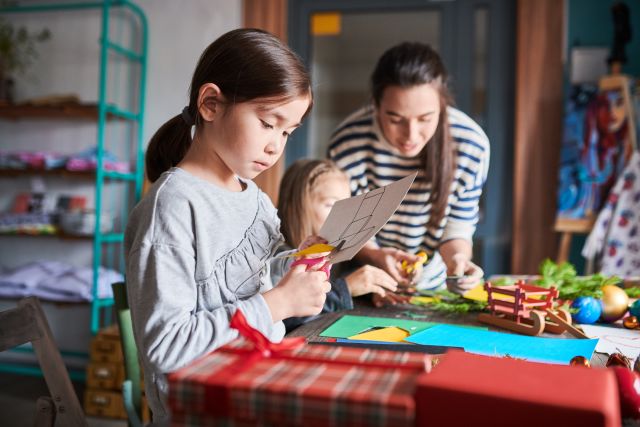Updated on April 9, 2020.
With schools closed and shelter in place orders in effect until further notice, parents across the United States are grappling with how to balance work duties with childcare and homeschooling responsibilities. This is an unprecedented time and many families are feeling the stress.
The good news? There are a wealth of resources available to get you through the days. Start by following these tips to help you develop and manage a sustainable—and fun—stay-at-home schedule for your family.
Break the day into blocks of time
Supervising a remote-learning curriculum for a home-bound child isn’t easy, and the challenge is compounded if you have multiple children in different age groups. It helps to remember that students in different grades have different capacities for attention.
The American Academy of Pediatrics (AAP) recently published guidance regarding schoolwork. Younger children can sustain about 20 minutes of class assignments followed by 10 minutes of physical activity, while older children and teens can focus on assignments for longer stretches, taking breaks between subjects or projects.
It may be tempting to have kids squeeze in as much work as they can, but taking periodic pauses will help kids of any age release pent-up energy and ultimately come back to lessons more energized and better able stay on task.
Remember that you know your children best. Some activities will hold their attention for longer than expected. Other times a task may simply not click and will need to be skipped. Embracing flexibility during this time can help everyone make it through the day.
Teach life skills
Chores don’t stop during a pandemic, and with all your newfound time at home, you probably have more cleaning to do. You may actually find that this is the perfect time to assign those responsibilities you’ve been meaning to for so long.
Involve your kids in important daily tasks—like laundry, food prep, tidying up, even paying bills online—based on what’s appropriate for their ages.
Make time for creativity
There’s often a limited amount of time allocated to the arts during a normal school day, but now the sky’s the limit. Consider keeping up with regular piano lessons via videoconferencing or encourage children to make paintings to mail to relatives, neighbors and friends. If you have loved ones who live nearby and you choose to hand deliver, just be sure to respect social distancing recommendations.
Get outside
Playtime may be more challenging now that libraries, gyms, museums and playgrounds are closed, but safely getting out of the house should still be a priority. If your usual hangouts aren’t an option, get creative for a change of scenery. Use whatever outdoor space you have—yards, porch, balcony or front steps. Set up a lunchtime picnic on a warm day or a small scavenger hunt.
Don’t have outdoor space? A simple walk around the block paired with a game of “I spy” can break up a long day.
Carve out some space
Depending on the size of your home (and your family), as the days drag on, you might find that siblings start to wage battles over shared turf. One smart move: help your kids set up designated areas in the house for them call their own for tackling schoolwork and for play. Make sure the space is comfortable, stocked with supplies and free from distractions. They may not be large in terms of square footage, but giving kids their own spot can help them maintain a sense of structure and predictability.
Tap into online learning
Younger children may not have access to school-based remote learning, but there are a number of online resources you can access to keep them engaged.
Scholastic’s Learn at Home site, for example, has made several weeks of lessons, videos, and activities available for free. Wide Open School from Common Sense Media has aggregated online educational resources across various disciplines, as well as information on emotional wellbeing and tips for kids with special needs.
Get moving
Even if sports are cancelled or parks are closed, there are plenty of ways to get moving. Take a break for an impromptu dance party, a yoga video on YouTube or an indoor obstacle course. Use painter’s tape to make hopscotch on the floor of your living room.
Keep general activity guidelines in mind as much as possible: the Centers for Disease Control and Prevention recommends around three hours of active time per day for children aged 3 to 5. Kids aged 6 to 17 should have at least 60 minutes of moderate to vigorous activity daily.
Set aside time for reading
It’s always a good idea to make books part of the daily routine. If your child is old enough to read independently, find a book to keep them occupied while you take a call or prep dinner. Have older kids read to your younger ones to encourage sibling bonding. And don’t forget about electronic books and audio books. Although many libraries are closed, many offer free electronic resources online.
Connect with friends and family
Social distancing can be lonely for everyone, so it’s important to make time for connection, whether that’s through Zoom, Skype, FaceTime or regular phone calls. Need a break from homeschooling? Consider asking a friend or relative to hold a virtual story hour or teach a science lesson.
Play social media to its strengths
Across the country and the world, parents and educators are coming together to share tips and activities to keep children entertained. For the toddler through kindergarten set, Instagram accounts and blogs like Busy Toddler and Days with Grey offer simple educational activities—no teaching degree required.
Celebrities are also joining in on the effort, with a variety of A-listers reading classic children’s books each day. The well-known children’s book illustrator Mo Willems was one of the first to leverage online platforms by offering daily drawing lessons via his “Lunch Doodles” series.
Watch a quality program
Sometimes we all need a break—and screen time rules can be flexible while we are all stuck at home. The AAP currently recommends that children under 5 limit their screen time to under an hour, while older kids should have frequent screen time breaks.
While limits are still important, it's understandable that these stressful circumstances will likely cause kids' screen media use to increase. Make a plan that works for your family and then research age-appropriate shows, movies and video games that your kids can enjoy. Common Sense Media is a good place to start.
At the end of the day, this situation is only temporary. It’s normal to feel like things are in survival mode every day. Just remember to focus on the basics and don’t stress too much about the details.






